Why Topical Gels Are a Game-Changer for Sciatica Pain
The best gel for sciatica can provide targeted relief without the side effects of oral medications. If you're dealing with that shooting pain from your lower back down to your legs, you're not alone - as many as 4 out of every 10 people will experience sciatica at some point in their lives.
Quick Answer - Best Gels for Sciatica:
- Penetrex Joint & Muscle Therapy - Best overall with arnica and MSM
- Biofreeze Cool the Pain Cream - Best cooling gel with 10% menthol
- Activene Anti-Inflammatory Gel - Best natural formula
- WELMATE Lidocaine Cream - Best for numbing (5% lidocaine)
Sciatica hits when something irritates or compresses your sciatic nerve - the largest nerve in your body. This can happen from a herniated disc, bone spurs, or spinal stenosis. The result? Pain that can range from a mild ache to sharp, burning sensations that make even simple movements difficult.
You're most likely to get sciatica between ages 30 and 50, but it can strike anyone. The pain typically starts in your lower back and travels through your hip, buttock, and down the back of your leg.
Here's where topical gels shine: they deliver pain-fighting ingredients directly to the source. Unlike pills that affect your whole body, gels work locally with very rare systemic side effects. As one pain specialist notes, "Topical medications tend to be very safe."
The key is finding the right formula with proven ingredients like menthol, capsaicin, lidocaine, or anti-inflammatory compounds that can interrupt pain signals and reduce inflammation right where you need it most.
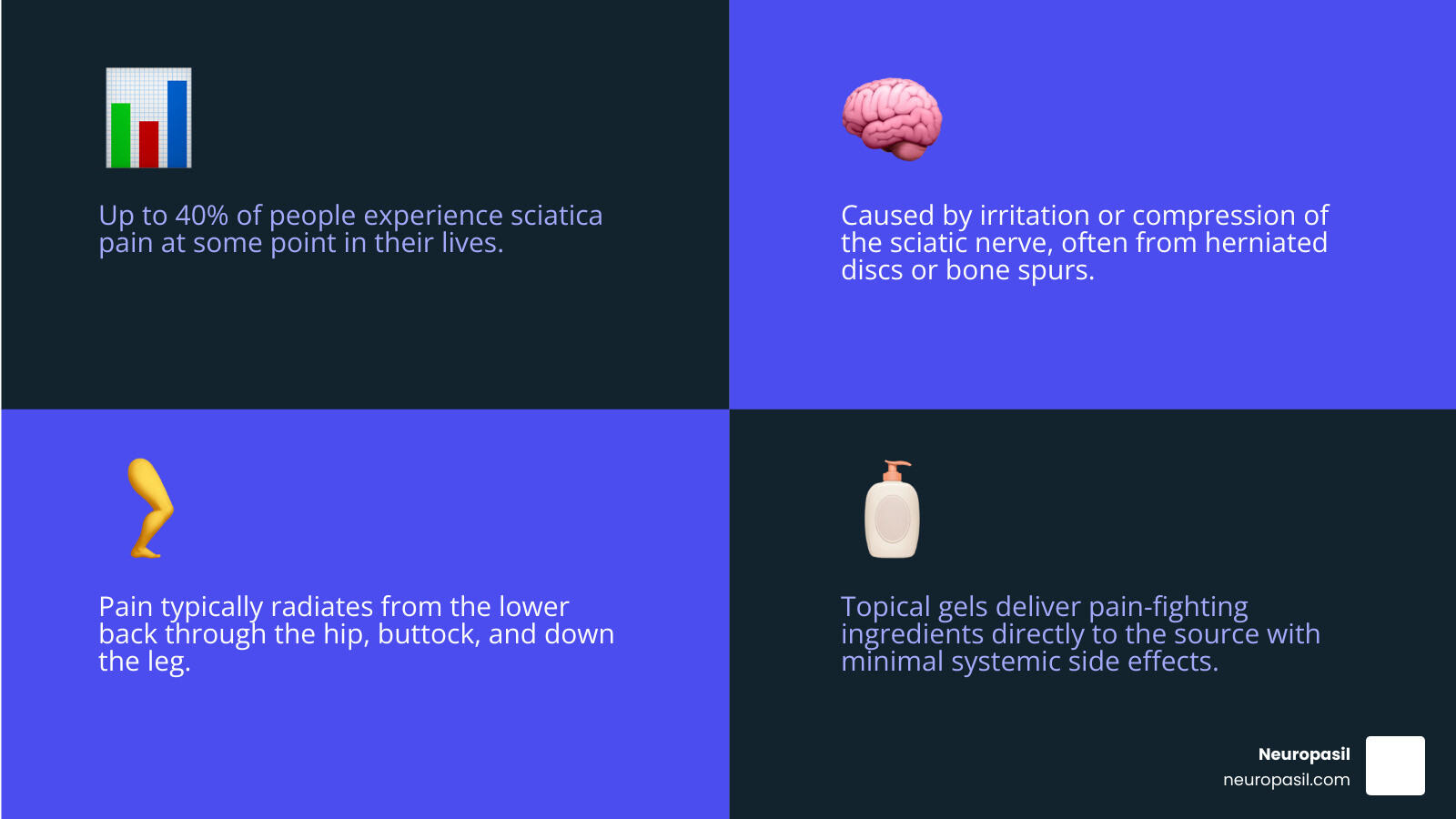
How Topical Gels Work for Sciatica Pain
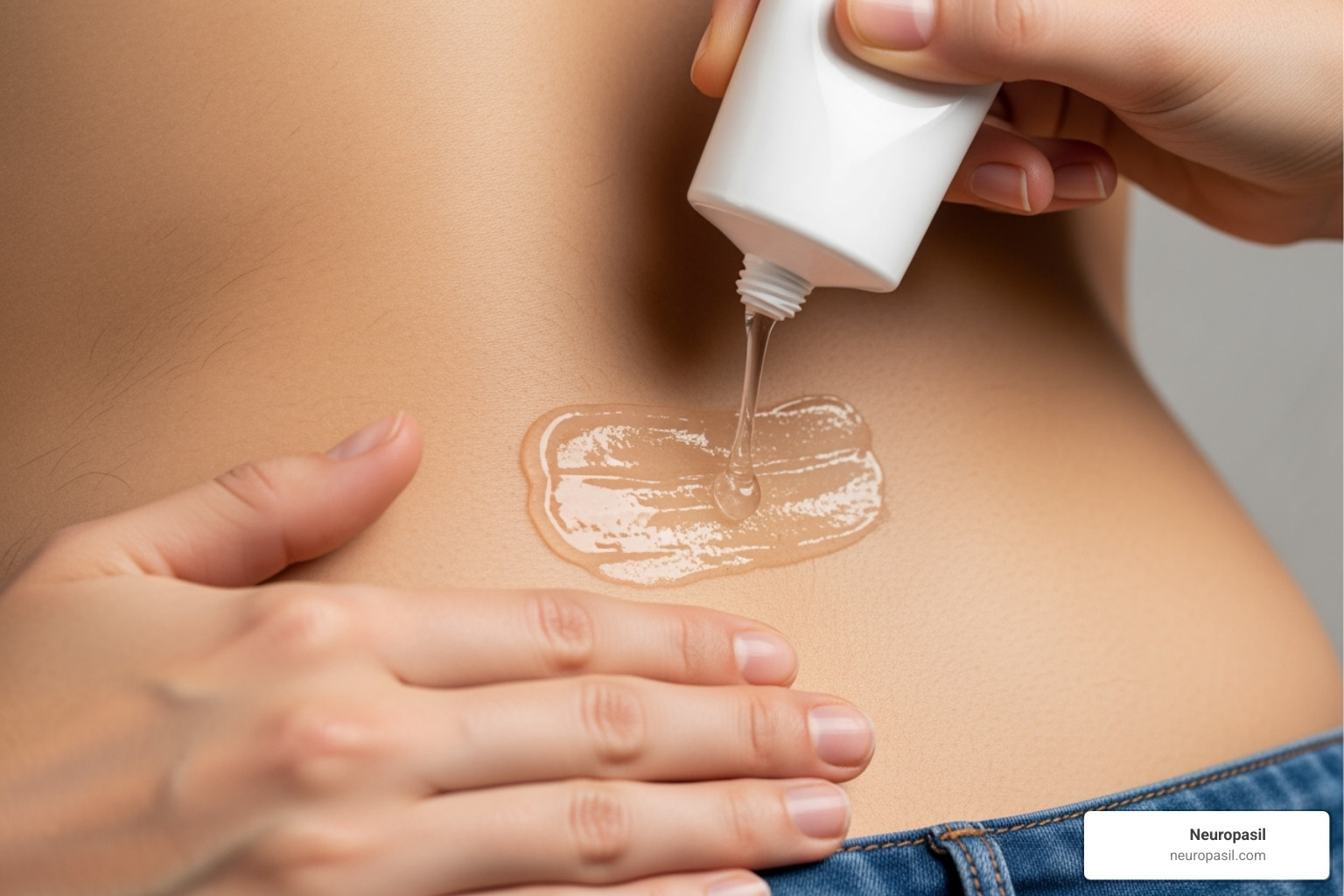
Think of your sciatic pain as a fire alarm that won't stop beeping. The best gel for sciatica works like having a direct line to turn off that alarm right at the source, instead of having to shut down the entire electrical system.
When you apply a topical gel to your lower back or along your leg, you're delivering active ingredients exactly where the pain lives. This targeted relief approach means you can get help without flooding your whole body with medication. As pain specialists note, "Topical medications tend to be very safe. It's very rare to get systemic side effects from topicals."
The magic happens through three main ways. Counter-irritation is like when you bump your knee and instinctively rub it - the rubbing sensation tells your brain to pay attention to that instead of the original pain. Ingredients like menthol and capsaicin work this way, creating cooling or warming sensations that override pain signals at your spinal cord level.
Anti-inflammatory action tackles the root problem. Many sciatica cases involve swelling that puts pressure on your nerve. Ingredients like arnica, MSM, and topical NSAIDs reduce this inflammation right where it's happening.
Finally, the numbing effect from ingredients like lidocaine temporarily blocks nerve signals altogether. It's like putting your pain on mute for a while, giving you blessed relief from those sharp, shooting sensations.
The beauty is that all this happens locally, with fewer systemic side effects than oral medications. Your stomach, liver, and kidneys can take a break while your back gets the help it needs. For more details on how these gels tackle muscle pain specifically, check out our guide on gel muscle pain relief.
Key Ingredients to Look For
Shopping for sciatica relief can feel overwhelming with all those ingredient lists. Let's break down what actually matters and why these components earn their spot in the best gel for sciatica formulas.
Menthol is your cooling friend - it creates that refreshing sensation that distracts your brain from pain signals. Think of it as nature's ice pack that doesn't need a freezer.
Capsaicin brings the heat, literally. This chili pepper extract does something clever: it gradually depletes substance P, the chemical messenger that carries pain signals to your brain. The more you use it, the less pain your nerves can report.
Lidocaine is the heavy hitter for numbing. At 5% strength (the maximum over-the-counter dose), it can temporarily block nerve signals and provide fast relief from sharp, shooting pain.
Arnica has been trusted for centuries as nature's anti-inflammatory. This herbal extract helps reduce both pain and swelling, especially after injuries or flare-ups.
MSM (methylsulfonylmethane) might sound like a chemistry experiment, but this organic sulfur compound is a gentle yet effective anti-inflammatory that many people swear by for reducing pain and swelling.
Diclofenac (NSAID) delivers anti-inflammatory power similar to ibuprofen, but works locally instead of affecting your whole system.
Vitamin B6 does double duty - it helps with pain while supporting nerve health and helping build new nerve structures. Frankincense rounds out many natural formulas with its research-backed ability to reduce nerve pain and inflammation.
Types of Sciatica Gels and Creams
Not all topical treatments are created equal, and understanding the different approaches can help you find what works best for your specific type of sciatica pain.
Counter-irritants are the most common type you'll find. These work by essentially giving your pain receptors something else to focus on. Whether it's the cooling sensation of menthol or the warming effect of capsaicin, they're playing a clever trick on your nervous system.
Cooling gels featuring menthol are perfect when your back feels hot and inflamed. That immediate cooling relief can be incredibly soothing during acute flare-ups. Warming gels with capsaicin work better for chronic, persistent pain - they increase blood flow and gradually desensitize nerve endings over time.
Topical anesthetics containing lidocaine are your go-to for intense, sharp pain. They literally numb the area, providing potent temporary relief when you need it most.
Topical NSAIDs like diclofenac gel target inflammation directly at the source. Instead of taking a pill that affects your whole body, you're delivering anti-inflammatory power exactly where the swelling is causing problems.
Natural and herbal formulas combine ingredients like arnica, MSM, frankincense, and plant extracts. These tend to be gentler and work well for people who prefer botanical approaches or have sensitive skin.
The key is matching the type of gel to your specific pain pattern and preferences. Some people need that immediate cooling relief, while others benefit more from the gradual warming and desensitizing effects of capsaicin-based products.
The Best Gel for Sciatica: Our Top Picks for 2025
Finding the right topical relief for your sciatica can feel overwhelming with so many options available. We've done the heavy lifting for you, testing and researching products that consistently deliver results. Our picks focus on effectiveness, quality ingredients, and real user satisfaction - because when you're dealing with nerve pain, you need solutions that actually work.
Best Overall Cream with Arnica & MSM
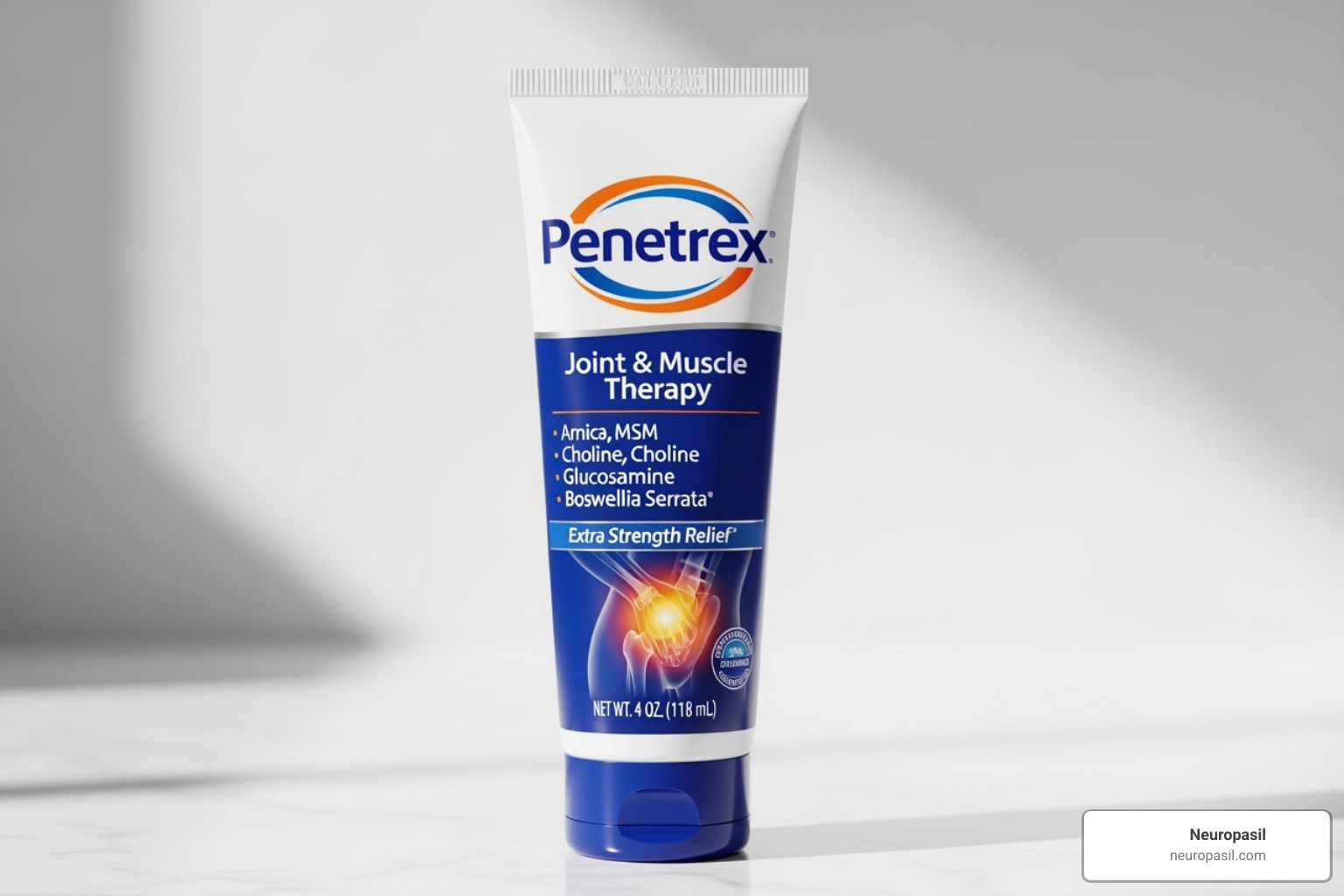
When we talk about the best gel for sciatica that covers all the bases, one type of cream consistently rises to the top. This isn't just another pain cream - it's a carefully crafted formula that tackles inflammation while supporting the body's natural healing process.
What makes this type of cream special is its powerhouse blend of arnica, Vitamin B6, MSM, and boswellia serrata. These ingredients work together like a well-orchestrated team, each playing a crucial role in reducing inflammation and supporting nerve health. The arnica fights swelling, while Vitamin B6 helps rebuild damaged nerve structures.
Users love that it's completely unscented and non-greasy, meaning you can apply it without worrying about a medicinal smell following you all day. One Amazon reviewer perfectly captured why this cream works so well: "I had a strong sciatic pain on my lower back down to my knees. This cream was magic to help me walk and do my almost normal activity till I got better."
The price point sits in the mid-range, but considering the quality ingredients and consistent results, most users find it's worth every penny for the relief it provides.
Best Cooling Gel with Menthol
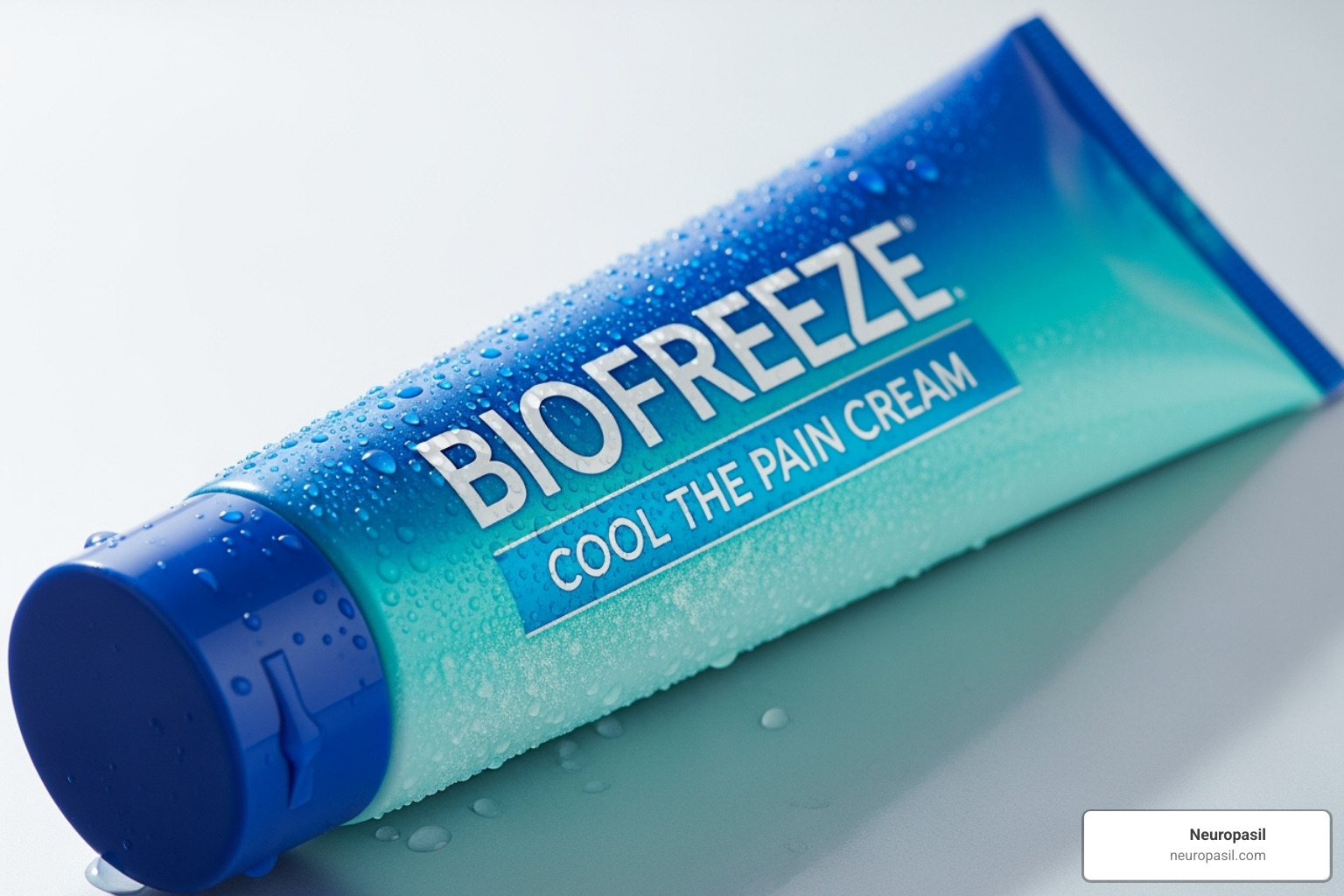
Sometimes you need relief right now, and that's where a powerful cooling gel shines. This type of gel has earned its reputation as a go-to for immediate sciatica relief, thanks to an impressive 10% menthol concentration that delivers a signature cooling sensation.
The beauty of a strong menthol gel lies in its simplicity and speed. Within minutes of application, the cooling effect kicks in, tricking your brain into focusing on the cool sensation instead of the shooting pain down your leg. It's fast-acting, non-greasy, and surprisingly affordable for how effective it is.
With thousands of five-star reviews online, the user feedback speaks volumes. One reviewer shared their experience: "It has a cooling sensation that provides immediate relief! I've suffered from sciatic pain for months and nothing seemed to work. It lasts for about 4 hours and then reapplication is needed."
The only downside? You'll need to reapply every few hours as the cooling effect wears off. But for many people with acute sciatica flares, that immediate relief is exactly what they need to get through their day. For more insights into how cooling sensations can be part of effective pain management, explore our guide on nerve pain relief.
Best Natural Formula Gel
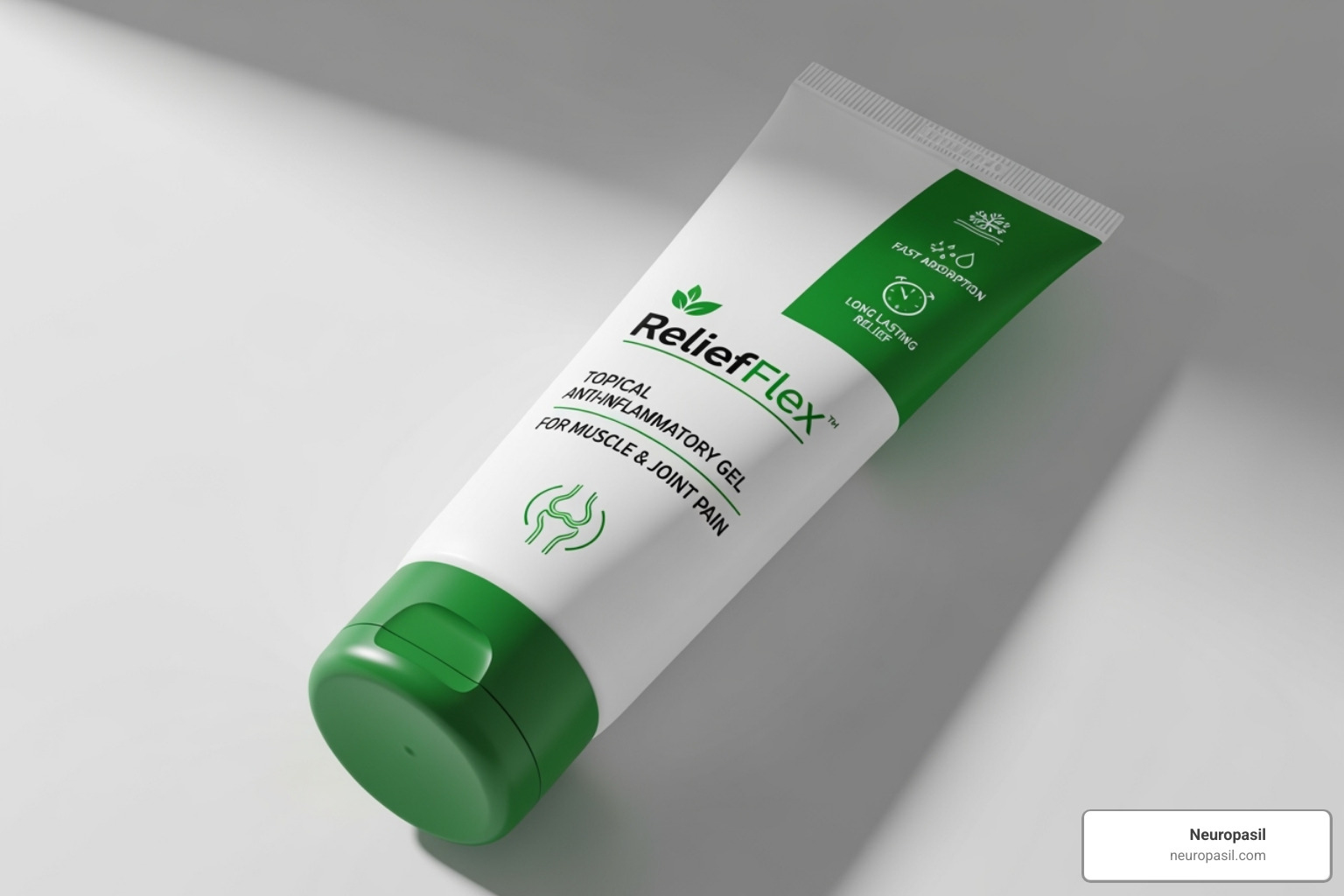
If you prefer a more natural approach to pain relief, some gels offer an impressive blend of botanical ingredients that work surprisingly well for sciatica. This type of gel stands out because it focuses on improving circulation to the affected area, which can significantly speed up your recovery.
The star ingredient is often ilex leaf extract, known for its circulation-boosting properties, combined with tried-and-true favorites like menthol, arnica, and tea tree oil. This combination creates a gel that provides immediate cooling relief and works to improve blood flow to your irritated sciatic nerve.
Users consistently praise the non-greasy gel formula that absorbs quickly without leaving residue. The fresh minty scent is pleasant, unlike some medicinal-smelling alternatives. One enthusiastic reviewer shared: "Absolutely loved it! This is the best thing I've found for pain relief in a long time! I have a lot of trouble with my sciatica and SI joint and this stuff works great and I have tried several things!"
What's particularly appealing about this approach is that it's holistic - rather than just masking pain, it works to address underlying circulation issues that can contribute to nerve irritation.
Best Numbing Cream with Lidocaine
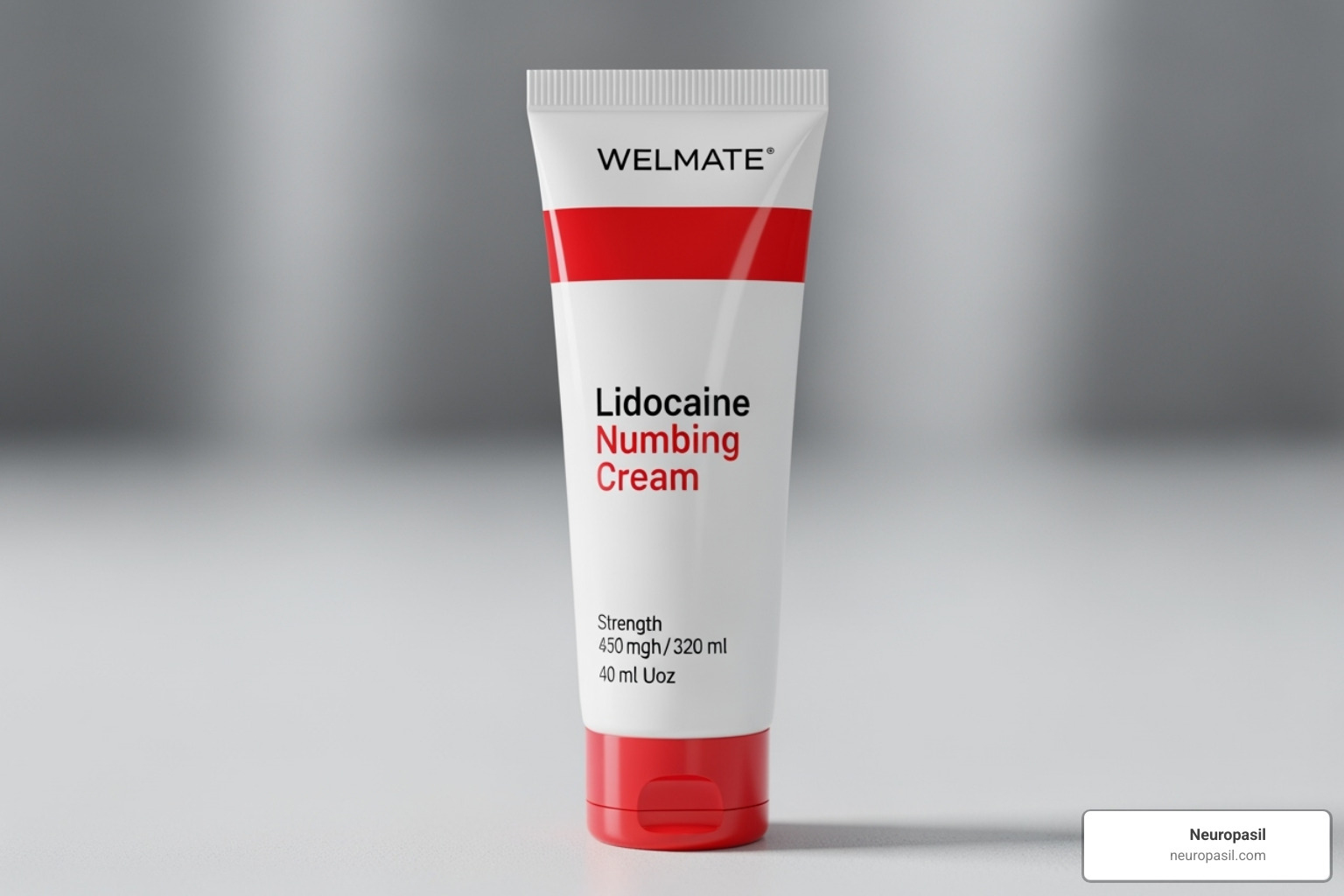
When sciatica pain is so intense that you need something stronger than cooling or warming sensations, lidocaine cream becomes your best friend. Look for a cream that delivers maximum over-the-counter strength with 5% lidocaine - the highest concentration available without a prescription.
This unscented cream works by temporarily blocking nerve signals in the treated area, creating a numbing effect that can provide significant relief from sharp, shooting sciatic pain. It's particularly effective for moments when the pain is so severe you can barely move.
Users appreciate how quickly it absorbs and how fast it works. One reviewer noted: "Hard to find 5% OTC at a local store. I purchased this product for sciatica pain and it helps so much! It absorbs well. No scent. Works fast. Lasts 3-4 hours at a time."
The numbing effect typically lasts 3-4 hours, giving you a solid window of relief to rest, sleep, or get through important activities. If you need this level of numbing frequently, it might be worth consulting a specialist - you can find a pain medicine specialist for a more comprehensive treatment approach.
While lidocaine is very effective, it's essentially a temporary fix. It's best used as part of a broader treatment plan that addresses the underlying cause of your sciatica.
Maximizing Relief: How to Use Gels and Other Treatments

Here's the thing about finding the best gel for sciatica - it's only part of the puzzle. While we love how these topical treatments can provide targeted relief without the stomach upset or drowsiness of oral medications, they work their magic best when they're part of a bigger game plan.
Think of sciatica gels as your reliable teammates, not solo players. They're fantastic at giving you the comfort you need to tackle other important treatments like physical therapy or gentle stretching. When your pain is manageable, you're more likely to stick with the exercises that actually help heal the underlying problem.
The beauty of a holistic approach is that each treatment supports the others. Your gel might calm the inflammation enough for you to sleep better, which helps your body heal. Better sleep means you have more energy for that physical therapy session, which strengthens your core and takes pressure off your sciatic nerve. It's a positive cycle that builds momentum toward real recovery.
How to Apply Gels for Maximum Effectiveness
Getting the most bang for your buck with sciatica gels isn't rocket science, but there are some smart strategies that can make a real difference in your results.
Start with the right spot. This might surprise you, but don't just focus on where the pain feels worst. Your sciatica pain might be screaming down your leg, but the real troublemaker is usually higher up. Apply your gel to the rear pelvis area (right behind your hip) and your lower back where those sciatic nerve roots emerge from your spine. You're treating the source, not just the symptoms.
Clean, dry skin absorbs better. It sounds obvious, but taking thirty seconds to clean the area first helps the active ingredients penetrate properly. No one wants to waste a good gel on dirty skin that blocks absorption.
The massage technique matters more than you might think. Don't just slap it on and walk away. Use your fingertips to gently work the gel into your skin with circular motions. This isn't just about absorption - you're also increasing blood flow to the area, which can improve the healing process.
Timing is everything when it comes to frequency. Most gels work best when applied 3 to 4 times daily, but always check your specific product's instructions. Some stronger formulations need more time between applications. Think of it like taking medication - consistency matters, but so does following the rules.
Here's a tip that might save you some discomfort: wash your hands thoroughly after each application unless you're treating hand pain. Trust us on this one - accidentally rubbing menthol or capsaicin in your eyes is not the kind of relief you're looking for!
Can Gels Be Used with Other Sciatica Treatments?
Absolutely! In fact, we'd be surprised if your healthcare provider recommended gels as your only treatment. The most successful sciatica recovery stories we hear involve people who use multiple approaches working together.
Physical therapy and stretching become so much more doable when you're not wincing through every movement. Apply your gel about 15-20 minutes before your exercises, and you might find yourself actually looking forward to that gentle yoga routine or those nerve glides your therapist recommended. Pain relief that helps you stay active is pain relief that pays dividends.
Oral medications can definitely team up with topical treatments, but this is where you want to have a conversation with your doctor. If you're using a topical NSAID gel along with oral ibuprofen or naproxen, your healthcare provider needs to know. They can help you avoid any unwanted interactions and make sure you're not overdoing it on any particular type of medication. For more detailed information about oral options, check out this resource on NSAIDs for sciatica.
Heat and cold therapy pair beautifully with gels, and you can get creative with the combinations. Some people love using a cooling gel right after a warm heating pad session. Others prefer applying a warming gel after ice therapy. There's no single "right" way - it's about what feels good to your body and provides the most relief.
The complementary approach is where things get really interesting. Maybe you're seeing a chiropractor, getting regular massages, or trying acupuncture. Your sciatica gel can be the steady, reliable support that makes all these other treatments more comfortable and effective.
Even the best gel for sciatica has its limits. As one expert puts it, these topical treatments "may not work for everyone and may not provide long-term relief." That's exactly why building a comprehensive treatment plan with your healthcare professional is so important. They can help you figure out which combination of treatments gives you the best shot at not just managing your pain, but actually getting better.
Frequently Asked Questions about Sciatica Gels
We get tons of questions from people trying to steer their sciatica journey with topical treatments. Whether you're wondering if that best gel for sciatica is working as it should, or if it's time to call your doctor, we've got you covered with the answers you need most.
When should I see a doctor for sciatica pain?
Look, we love a good success story with topical gels, but sometimes your body is telling you it needs more help than a cream can provide. While gels can work wonders for mild to moderate sciatica, there are definitely red flags that mean it's time to put down the tube and pick up the phone.
Pain that sticks around for weeks despite your best efforts with gels and self-care isn't just being stubborn - it's your body asking for professional backup. If your pain is getting worse instead of better, or if it's so severe that you can't function normally, don't tough it out any longer.
Here's where things get serious: muscle weakness, numbness, or tingling in your leg or foot could signal nerve damage that needs immediate attention. And if you experience loss of bladder or bowel control, drop everything and get to an emergency room - this rare condition called cauda equina syndrome is a medical emergency.
Other warning signs include unexplained weight loss, fever, or pain that wakes you up at night. These symptoms could point to underlying conditions that go way beyond what any topical treatment can handle.
As Harvard Health puts it, you should "call your doctor if sciatica symptoms are not improving or responding to home remedies, or if you experience muscle weakness or significant changes to bowel or bladder habits." Trust your instincts - if something feels seriously wrong, it probably is.
Are natural or alternative topical treatments effective?
The short answer? Many people swear by them, and there's actually some solid science backing up several natural ingredients. The longer answer is that effectiveness varies from person to person, so what works like magic for your neighbor might not do much for you.
Arnica has earned its reputation as a natural pain-fighter, with many users finding real relief from its anti-inflammatory properties. Capsaicin might burn a little at first, but it's actually working to deplete something called Substance P - basically turning down the volume on your pain signals over time.
Menthol provides that refreshing cooling sensation that can distract your brain from pain, while frankincense and myrrh - yes, like the Biblical gifts - have been studied for their potential to reduce nerve pain and inflammation. Pretty cool that ancient remedies are getting modern validation, right?
The thing about natural treatments is that they often work more gently than synthetic alternatives, which some people prefer. However, "gentle" doesn't always mean "weak" - these ingredients can be quite effective when formulated properly.
The effectiveness varies by individual, so don't get discouraged if the first natural gel you try doesn't work miracles. It might take some experimenting to find your perfect match. For more insights into natural approaches, check out our guide on natural solutions for nerve pain.
What's the difference between a gel and a cream?
While people often use these terms interchangeably when shopping for the best gel for sciatica, there are some real differences that might influence which one works better for you.
Gels are typically water-based and non-greasy - they're usually clear or translucent with that jelly-like consistency you'd expect. They absorb quickly into your skin and often provide a cooling sensation as they dry. If you hate that sticky, greasy feeling, gels are usually your friend.
Creams are thicker and more moisturizing, with that opaque, richer texture that comes from their oil-and-water base. They take a bit longer to absorb and can leave a slight residue, but some people find this more nourishing, especially if they have dry skin.
In terms of absorption rate, gels typically win the speed contest because of their water base. Creams might hang around on the surface a bit longer, which isn't necessarily bad - it just depends on your preference and lifestyle.
For sciatica relief, both can be equally effective depending on their active ingredients. It really comes down to personal preference: Do you want something that disappears quickly into your skin, or do you prefer that longer-lasting, more substantial feel? Neither choice is wrong - it's all about what makes you more likely to stick with your pain management routine.
Conclusion: Finding Your Path to Sciatica Relief
Living with sciatica doesn't have to mean accepting constant pain as your new normal. Throughout this journey together, we've explored how the best gel for sciatica can become a powerful ally in your fight against nerve pain, offering targeted relief exactly where you need it most.
What makes these topical treatments so remarkable is their ability to deliver potent, pain-fighting ingredients directly to the source of your discomfort. Whether it's the cooling relief of menthol, the numbing power of lidocaine, or the anti-inflammatory benefits of arnica and MSM, each ingredient plays a crucial role in interrupting those painful signals traveling down your sciatic nerve.
The beauty of gels and creams lies in their safety profile too. Unlike oral medications that affect your entire system, topical treatments work locally with minimal side effects. This means you can find relief without worrying about the stomach upset or drowsiness that sometimes comes with pills.
But here's what we've learned matters most: finding the right gel is just the beginning. The most effective approach combines your chosen topical treatment with other therapies. Maybe that's gentle stretching in the morning, physical therapy twice a week, or alternating heat and cold packs. When you create this comprehensive plan, you're not just managing today's pain - you're building a foundation for long-term relief.
Everyone's sciatica journey is different. What works wonderfully for your neighbor might not be your perfect match, and that's completely normal. The key is being patient with yourself as you find your ideal combination of treatments.
A holistic treatment plan truly is the key to lasting relief. Your topical gel provides the immediate comfort that makes movement possible, while physical therapy and other treatments address the underlying causes keeping your pain alive.
At Neuropasil, we understand how frustrating nerve pain can be, and we're here to support you with resources and solutions designed specifically for nerve health. Our team is committed to helping you steer this journey with confidence and hope.
Don't let sciatica control another day of your life. Take that first step toward relief by choosing a quality topical treatment, and remember that lasting comfort is absolutely within your reach. For more comprehensive strategies and insights into managing your symptoms, learn more about managing sciatica pain on our dedicated resource page.
Your path to relief starts now - and we're here to walk it with you every step of the way.














